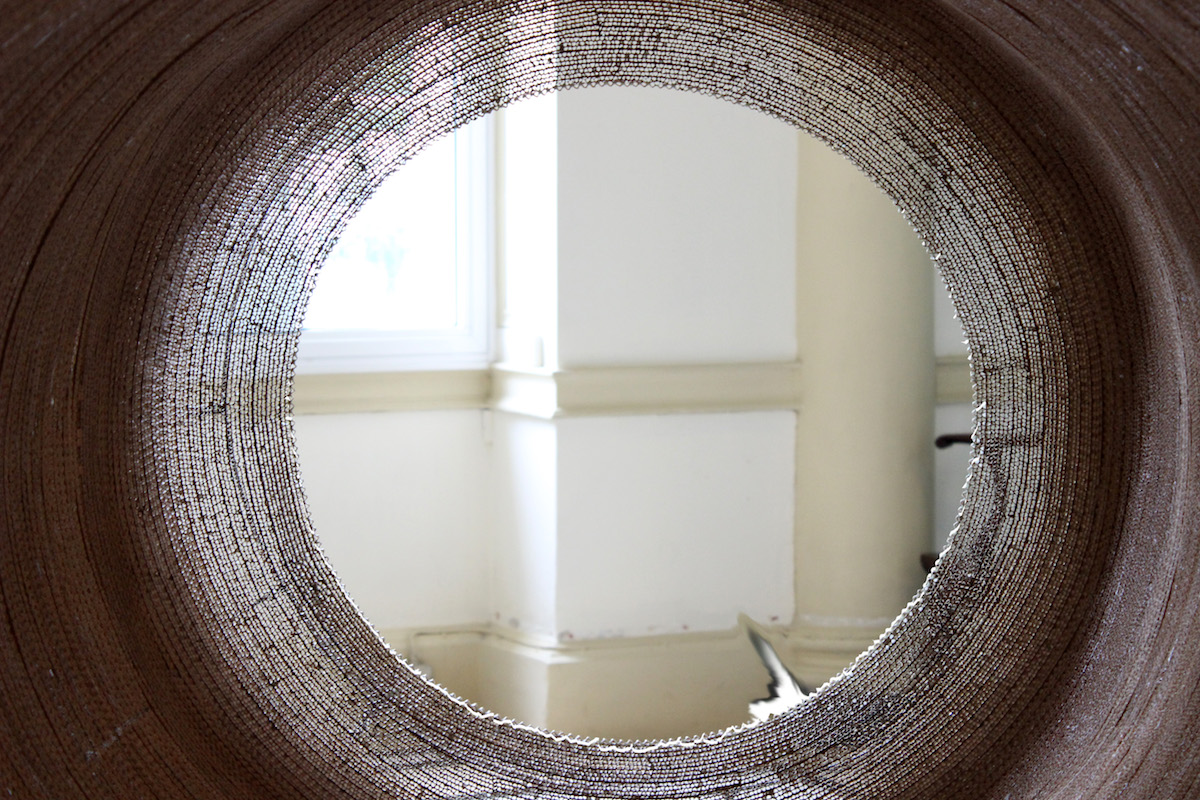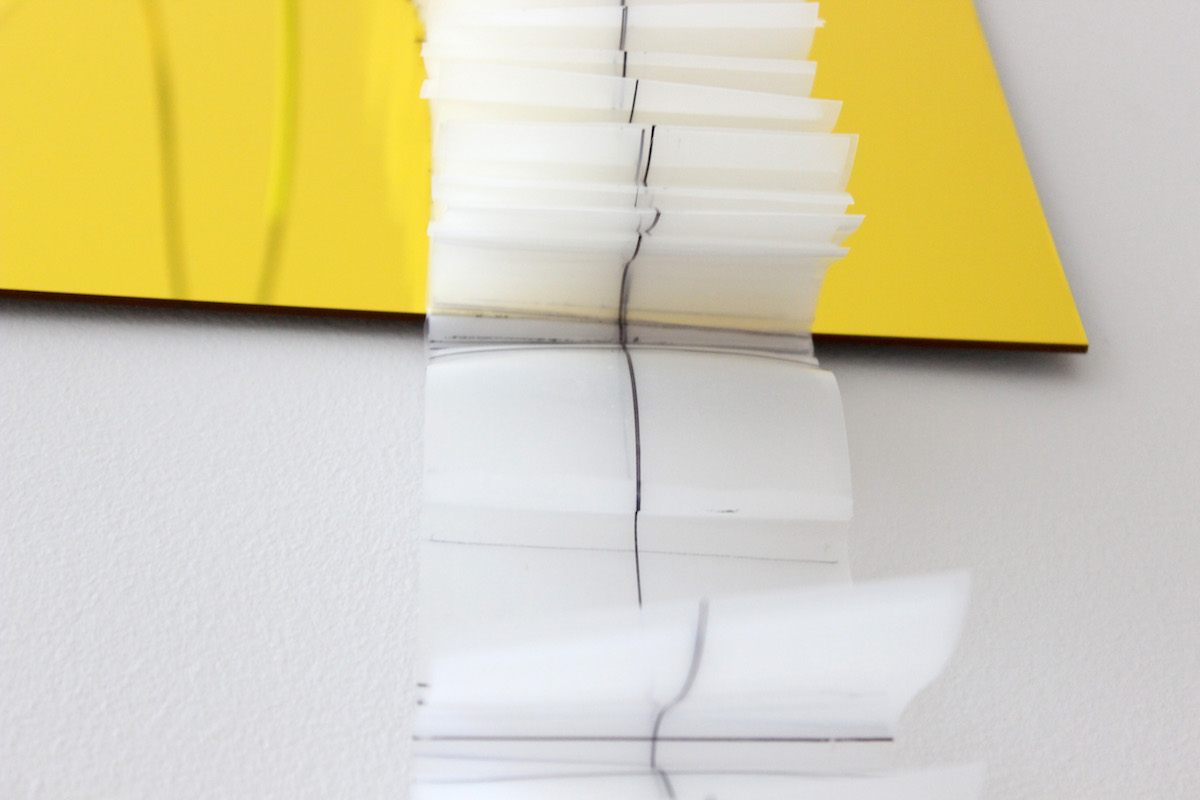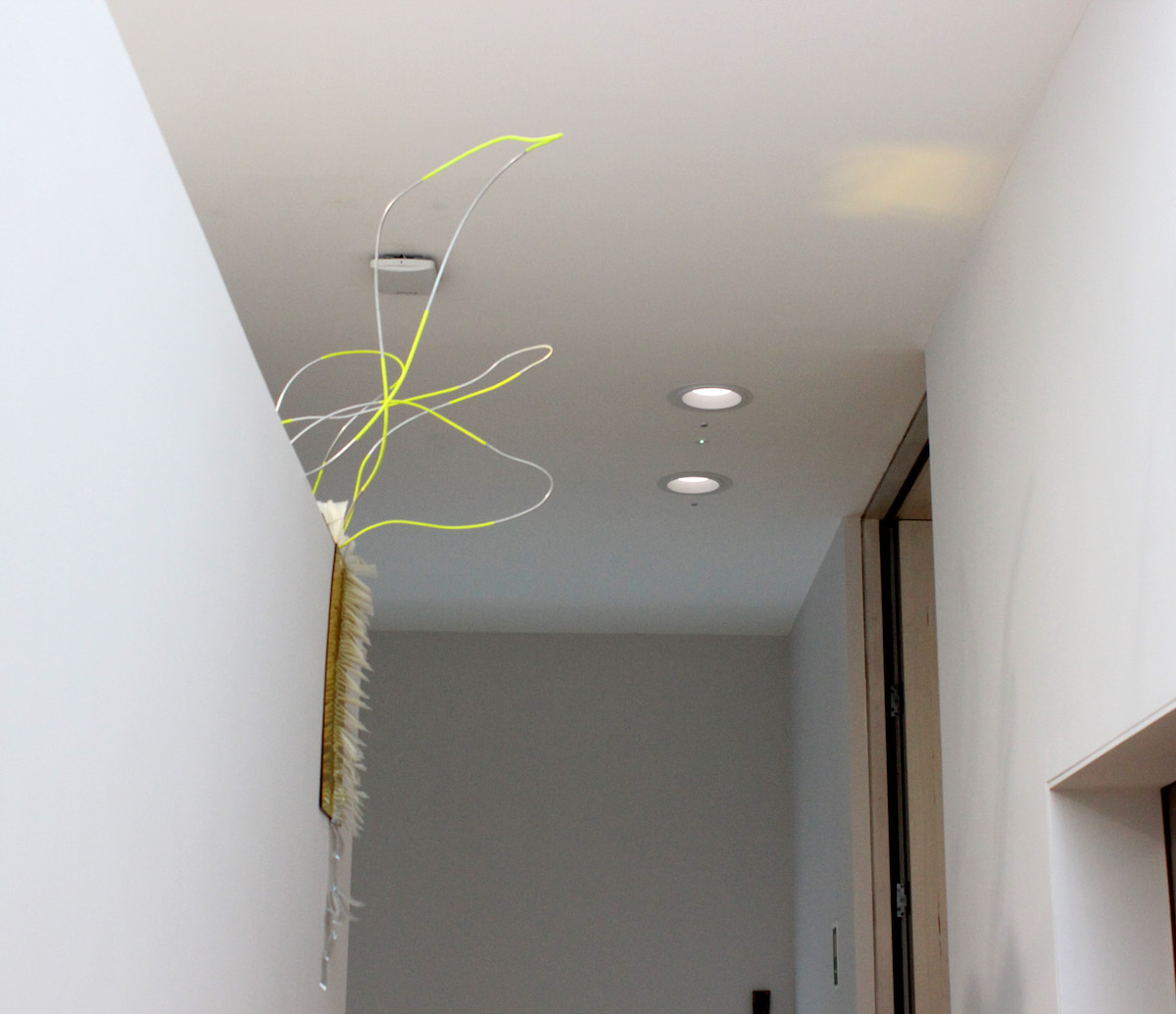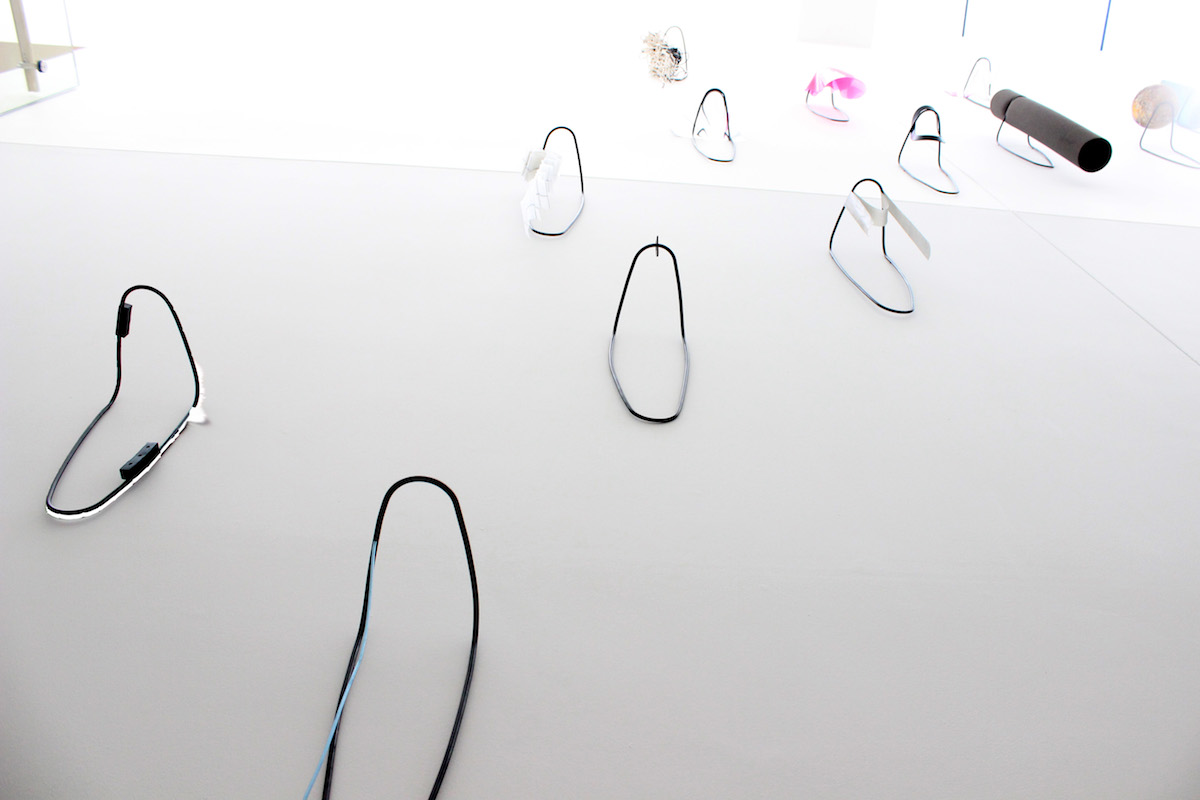In this piece I want to share my reflections on visiting a consequence of – a dappled world an exhibition of Maud Cotter’s work at The Hugh Lane Gallery, Dublin in June 2021. In articulating this experience from within the context of the post-lockdown re-opening of public spaces, I explore new forms of awareness that we carry with us surrounding points of contact, of touch, and actions of transmission.
The title for this exhibition comes from a poem by Gerard Manley Hopkins entitled Pied Beauty, where he writes of “dappled things”. For him, ‘Things’ in their nature hold variety, an existing within their own material agency and qualities dictating their actions. As we sit here with these thoughts, among the manifestations of Maud Cotter’s processes, they start to co-mingle with the second half of Hopkins’ poem in which “All things counter, original, spare, strange” are further seeking and desiring to see the counter halves, the other, the abandoned state and nature of materials and forms. The poem resonates with the ethos of looking closely, of collecting abandoned objects, and most importantly of spending time with these materials, understanding their innate properties, and then stretching and pulling their limits, as Cotter has spoken about many times.
In relation to the titling of her work, and the action of forming pieces of language around an object or sculptural experience, she says “A title is a device to excavate the mind”, a form of stepping into the work and giving it voice. Poetry and lyrical expressions of sensation seem to be inherently built into the fabric of Cotter’s practice, building close lines of communication between words and their embodied resonances with the sculptural work.
The body of work for A Consequence of – a dappled world, has developed since 2015 through three exhibitions: at the Limerick City Gallery of Art in 2018, The Dock, Carrick-on-Shannon in 2019, and concluding with this exhibition in The Hugh Lane Art Gallery in June 2021. All three interrogate the material language in operation between human and nonhuman matter and understand the innate vitality within the material body of each object, each synthetic piece of matter expressing its own agency and sensation in relation to the architecture of the site.
Delicately, ever present within Cotter’s work, are these words she mentioned in a recent interview by poet Susan Howe which accompanies me throughout the exhibition:
“In poetry
all things seem to touch so they are”
There is a weighted sensation upon first walking into the gallery space. A hot pressure of gallery air being caught and bubbled into the face mask pressing across the face. We are becoming used to this. But it is an ever-present reminder of our changed physical circumstances.
The space is navigated within a specific flight path, allowing bodies to course through, to weave between each other’s at narrow points, or come close to a piece of work, growing quiet, lowering themselves body to body. But in lingering, the path is blocked, the bodies cluster together, and that pressure of heated person to heated person grows tense. Public, individual, anonymous shared space holds a consequence of direct impact which hovers as potential when we enter, the consequence of the human body’s trace across a surface. This consequence of contact which lingers in our awareness and impacts the commonalities of these material experiences as I move throughout the works.
There is a keen awareness of your individual body, putting one foot in front of the other slowly as you circulate the room in rhythm with the works. Considering the silent contexts that fill every inch of the gallery floor, the concerns, the postponements, the hyperawareness of each breath, and the almost palpable comfort of these new old spaces. The positioning and build-up of this exhibition was carried throughout the various national lockdowns in response to the Covid-19 pandemic, thus at a great distance from the site of the gallery. And I ask, how did this affect the the interrelationships of the work with the site itself?
In online talks during the last year, Cotter talked about the process of making the work, from her studio at home and the workshops of the National Sculpture Factory in Cork, to the occupation of the Hugh Lane Gallery. The rhythm of re-visitation and visualization comes through, and I cannot help but imagine the artist occupying each and every one of these rooms, her presence lingering, watching the flight paths of the space, the falling of the light, the interruptions and fissures within the body of the architectural site. These small actions of noticing are key, both to her form of installation, responding viscerally through how the works are left to occupy the space once the artist’s body is gone, and also to the viewer’s experience moving within the space.
Throughout the national lockdowns of 2020 and 2021 we have collectively been offered and given access to many virtual/digital experiences, videos, photographs, talks, virtual reality walk-throughs, galleries in all but skin. However, now navigating the nooks and crannies of lived space, the sensations are immediately mediated through a different language. The focus and movement of the body are controlled by the viewer, no longer held by the control of the camera’s positioning. Almost incidentally this impacts our ability to perceive a work at all levels of connection.
These actions of controlling the body to view digitally, holding the head and bending the neck in order to construct something closer to simulation, take away core intuitive and intimate moments that build up through how we enter a space; how long we spend in each room, how we turn to a piece of work or away from it.
There is sterility, a lack of small noticing, that happen when the body is filtered and held through a camera’s lens, impacting key elements which are intimately connected to experiencing works haptically.
I cannot seem to shake away the circumstances of my viewing from every corner of my experience. I am not sure if any of us can.
We are greeted first by the pressure of the text on the wall, the hand-drawn titling stretched across the galleries. The pencil lettering has been created in collaboration with a calligrapher and is based on children’s hand writing from the 1940s. There is a spectral trace of the hand of the artist in the soft touches of the pencil line, but equally a hovering space where the hands of the original writers, the children’s script from which Cotter drew inspiration, as a ghost of authorial pressure across the wall.
The physicality and the labour of making the mark are present in every element. These calligraphic shadows softly give us the titles and voices to each piece, and draw attention to the artist’s own hand across the whole exhibition:
We see the shadow lines of positioning, of hands installing, and the linking of objects, bringing them to points and intra-connection and contact through pencil lines.
The residual marks of positioning, found within the interlinking lines of a dappled world, pulse lines of object connected to object. Slit embodies this stunning moment of imperceptible touch, wrapping itself around, through, in between the threshold space, overtly showing the puncturing of matter intercepting matter as it holds the body of the building.
In a recent interview Cotter talked about the intimacy generated by spending time in one place or with one object, spending time learning the nature of a material or a space: intimacy as active material, like dust particles, interrupting and allowing points of contact.
This intimacy is another way of experiencing the labour and study within each active component of this installation. Some intentions of the material investigation continually explored by Cotter are shared in a video placed in the entryway of the gallery, where she talks about the examination process through which each material is tested; its inherent material qualities and actions engaged with, and its natural performance in the world recognized, used as tool of communication, and pushed beyond its capacity. Embarking through these methods to find vitality and instinctive action, unpacking the nature of man-made matter, and stretching out the limits of how it may be experienced and performed.
Plastics, rubber, and other synthetic materials come to the fore throughout this exhibition. Cotter acknowledges the material crisis and ethical considerations when using and producing these forms of matter, and draws that ethical dilemma into her works, consciously working with the resonant properties within man-made matter and “re-examining the nature of physical reality.”
In a breather of air some of these considerations and interrogations are acknowledged: rocks only wearing the skin of rocks with none of their material properties, bearing false weight, evoking the sensation of air moving through taut billowing lungs. False, polythene lungs, in a still room. It is in the presence of Cotter’s new work something else that I find myself aware of the action of touch. There is a delicate hovering above, an encounter of intra-action of sculptural object/material and architectural space of the gallery. Experiencing the extension of the light’s reflection as a hand delicately touching the wall of the gallery site.
The soft pressing of shadow across surface, and the body’s positioning at the heart of this exchange of contact, became the heart of the exhibition.
Shadows touching walls, lightly impacting, a series of performative actions of touch, resting and impacting the moments it has within this structure.
In the atrium, the liminal hallway space, the body is asked to linger, to pause as materials affect the architectural site. Brushing past, this is an encounter with light, the glinting of gold blushing and resting a fingertip on the opposing wall of the space and bouncing from wall to wall. Your body cannot completely access this experience: you crane your head, climb, half climb stairs, you stand at angles and in corners, you pass the length of the corridor in order to understand the material exchange. Yet by the very nature of its occupation of this threshold space, the experience, the object, and its impact, are all transitory, a liminal material action, in a corridor, a space for passage, hostile towards indefinite occupancy. You are positioned below the works, peering upwards, or in close proximity to them. The container forms of watery life & rock holding within and without a variety of material forms, plastics, rubber, glass, metal. Do not linger, your body feels the uncomfortable twinges of knowing you are in the way, that someone is carefully trying to pass by. The narrowness is ever present, and becomes a key element of the work.
The imposition of the in-between moment you are caught in, the action of dappled light casting and touching, suspended in the action of its titling.
Perch is another example of form being held in relation to the gallery site, inhabiting the very qualities of its name. The form is holding on and equally held by the cradling nature of the space and the curvature of its spine.
In viewing these objects as a continuous sequence of matter at the precipice of touch, it feels as if these materials are acting with a similar weighted hesitancy, above the surface, impacting incidentally, as we all collectively move through these public spaces. There is a similar sensation of pressurized space between the individuals, as with the heavy shadows highlighting the in-between nature of these material bodies relating to the gallery site.
I am reminded of ‘touchpoints’, points of contact as an implication which sits at the crux of a shared understanding. That two or more bodies enter into a space, carrying with them their weights and viscosities, and repeatedly come into contact with surfaces. Thinking about the changing uses of these words through the indiscretion of soft societal action. ‘Touchpoints’ are now to be cleaned every hour: door handles, light switches, appliance handles, table tops, etc. The Covid-19 pandemic brought many new layers to the collective incidence of any public exchange, activating both new and old concerns of vulnerability when entering a public space, such as a gallery site.
Now, after so many waves of digital fatigue, touch starvation, we all have these growing longings which show the necessity for physical experiences As we move off Zoom, tentatively, the impact results in a resurgence of the tactile gallery installation, intimate concerts, bookable group viewings, painterly tactile hung walls full of human marks, and swathes of touchable take-able pieces of paper.
Even before the pandemic gave us cause for such awareness, there was a push to move back to physical experiences, bespoke artists’ experiences that are only accessible to small quantities of bodies who then further report on the action through documentation.
The varying threads of the tacit hungry bodies now move about the world hesitantly, awash with experiences which give us only more questions about how to seek experiences across these technological surfaces. This casts an interesting consequential shadow across the visceral work that Cotter gives us, developing a presence across synthetic and organic material which activates the boundaries primarily of man-made entities living in relation to our bodies, breathing in relation to the gallery’s body. We, the viewer, hold a hyperawareness towards proximity at the moment which further pushes the interrogation of material research and which weaves coils of human and non-human material experience tessellating at the centre of how we have materially mediated, articulated and experienced the last two years.
I ask then, what has this time activated within the individual viewer/consumer? How can this help construct the safe and important stages for creative experience?
This is of course not the time for halves or wholes of answers, but by acknowledging the changes to the sensations produced by public spaces, and by holding our active awareness of touch and transmission as new layers to perceiving the occupation of shared space, it can allow for new modes of considering our proximity to material languages and our impacts through, against, and within them.
There are so many layers to the changing textures and wants of skin that have come from the impact of this time, so perhaps it helps to sit within the foundation of our own experience, and I feel that it is the pressure between materials that reminds us this is the language of experience, the one we will push to continuously occupy.
And with this in mind, here are the touching points found walking in this moment, in this space, with the hand of the artist impacting our surfaces collectively in a material exchange held in the gallery site.
A Consequence of – a dappled world solidifies in the material presence and technological silence of its particular sculptural language the importance of these forms of research, but predominantly the importance of material language as a concrete form of communication needed for the visceral bodies we inhabit.
The works echo and hold up the delicate matter of time – collecting, communicating, and understanding how each piece of material operates, what it needs, and how it is to exist in the microcosm of material experience facilitated in this exhibition. This is the tender practice of sculpture, to spend time, to collect and examine deeply the material states within the world. To be in a space that is the aftermath of sculptural action, to think about Maud’s experience of making these works – how the materials bent and settled, how her hands delicately trained wood and metal to bend following a year and a half of not occupying these consequences – has made the starvation for physical experience monumental. And the heightened awareness of my body taking up space in relation to each piece becomes a new hyperawareness of my own physicality.
I am grateful to once more be within a consequence of touch.




